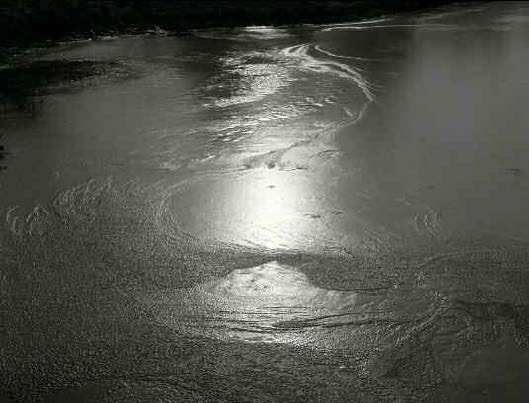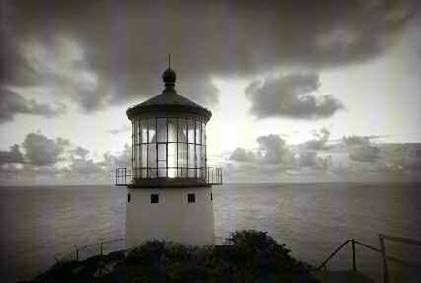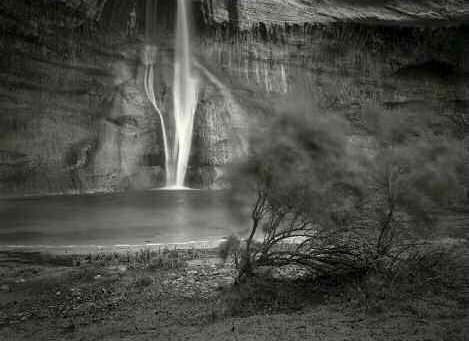
The most powerful teachings and teachers are those that bring us back to ourselves, as we are now, helping us see our true nature: vulnerable and exposed, along with both our nascent strengths and formidable obstacles. My own entry into world of the spirit and inner development came through art and photography, with compassionate yet unforgiving teachers.
On a New Year’s Eve—over forty years ago—I gathered with some of my peers at the home of our photography teacher, Nicholas Hlobeczy. Young and eager, we embarked on an evening of looking at photographs, listening to music, and sharing vital conversation. We each showed our newest work, our youthful most-polished efforts, waiting, wishing, hoping for positive response from Nicholas. I remember being nervous about what I was showing and feeling inwardly that something was amiss. Even then, an inner measure existed that could sense but not fully identify the features of a subtle imbalance. It was as if I was knowingly and happily living a lie. Some part of me did not want to be found out, even by myself—especially by myself. But mostly, I consented to this false pretense since I had no idea where the vague sense of deception was to be found.
As we each showed our images that had been made with care and as much technical expertise as we could muster—work that emulated the great photographs of the day—Nicholas was visibly unmoved and quiet. Finally, he started leafing through the prints and proofs scattered throughout the room, shown in relief against the dark oriental rug. We observed a growing clarity and sparkle in his eyes.
He gathered up all of our finished prints and casually placed them aside in a pile. Several small proofs and stray images, tangential to our serious efforts, remained in the center of the room. “Little pictures,” he said, with no explanation or introduction. “Little pictures,” he repeated with force and emphasis as he picked them up, one by one, holding them where we could all see and observe them carefully.
He eventually continued with his response: “Pictures from essence, of child-like perceptions, real pictures of who you really are.” It was true. The small pile of “little” pictures were real. They were an accurate reflection and struck a note of truth. They were not about ambition or polish or future greatness. They were about reality, a genuine portrayal of the present, and they reflected our authentic selves. As a result, they were unimpeachable—and remarkable—in precisely the way that we wished and hoped that our other images might become. This experience gave us something to aim toward.
One set of images—the “little pictures”—grew directly from our essence. The other set of images were full of the strivings of our ego to be good, to be like the masters, and to be admired. In a moment we saw and deeply appreciated the difference. For the very first time, I caught a glimpse of my youthful, bombastic ego and its desire to be liked and recognized. And, with clarity, I saw something of my true nature. It was a small glimpse, to be sure, but it rang of integrity and not false pretense. We were, on the one hand, embarrassed by our ego’s antics, and on the other hand, extremely grateful for this important discovery, this moment of understanding that Nicholas revealed.
Nicholas continued: “Can we make ‘little pictures?’ Can we practice non-doing and simply allow our images to find us? Can we bring to light what is really our own—in truth,” he said, “not in imagination?”
Turns out, we stayed up all night on that New Year’s Eve and ventured out to make photographs at dawn, with the singular intent of being open to the images that may find us. I photographed ice formations on a pond in which the forms and shapes precisely mirrored the condition of my inner landscape. I saw a serpentine-like shape in the ice, with light radiating from the center—in a way that struck me in the heart of my solar plexus. In the midst of this radiant light were mysterious dark, rigid textures that were obstacles to the overspreading luminosity. It came as a revelation, the strength of my connection to the image. It honestly felt like my own—one of the first decisive moments to find its way through my camera aligned with my heart and mind. When I drove home later that day, I felt that something had changed in me, a significant inner measure had been uncovered for the very first time—an experience that has never left me.
Our essence, what is real in us, speaks in whispers. It is often hidden beneath well-constructed personalities. We are a mixture of essence and personality. Yet, we see certain ways of being, certain interests, certain ways of expressing ourselves, certain ways of interacting with the world and others, that we can call our own. These inner conditions have a different ring. They are resonant. They sound true. They feel more right.
One distinguishing feature of this period of the time surrounding that New Year’s Eve: I was sitting quietly, meditating on a daily basis, and making an active effort to maintain an awareness of myself during parts of the day. My wish to awaken was great. I tried to stay within my body, to receive the silence—and to listen within. This effort of attention felt like a “knocking on heaven’s door,” opening to a source of wisdom, lying just beyond the threshold of my consciousness, that seemed to be waiting to reveal itself to me. This wisdom, this knowledge, I suspect, is always there—it is we who are absent most of the time.

EARLY GIFTS OF THE SPIRIT
Often at the beginning of our spiritual search, many of us are given what I call “early gifts of the spirit.” We are shown the way and offered glimpses of our possibilities. It is through these moments of revelation that we come to realize that we must earn entry to this new world by dint of our efforts and personal initiative. But we must strive to maintain the state of innocence and the quality of not-knowing that characterized our early search when our wish to awaken was strong and we were not yet governed by rationality and concepts. “In the beginner’s mind there are many possibilities; in the expert’s mind there are few,” writes Shunru Suzuki in Zen Mind, Beginner’s Mind. He continues, “All self-centered thoughts limit our vast mind. When we have no thought of achievement, no thought of self, we are true beginners. Then we can really learn something… . This is also the real secret of the arts: always be a beginner.”
In my sitting practice during this period, I regularly experienced the delicate fire of inner energy moving through my body, up from the sexual region to my head. I felt whole, as if this energy became an integrating and coordinating force, subordinating the rest of me into its greater wisdom. As the energy rose through my system, I began to feel another remarkable condition. I felt a deep, generous, intense, and impersonal love that connected me to all living things. I would simply look at my friends, feeling overwhelming love and compassion, and could say nothing. I could not express the fullness of this awakened love.
For a brief period of time, I was given a unity of being, a blissful happiness that accepted all, rejected nothing. My experiences today do not match the intensity of those early years, but they now feel as if an inner wholeness beckons and the force of presence is very gradually subordinating my parts into a gradual integration. Presently, experiences of this finer energy reveal themselves occasionally in the midst of everyday life through meditation and efforts towards mindful attention. It is now an organic process and I feel more prepared with the proper psychological, emotional, and physical grounding. The dark complexes and angst of my early years has mellowed substantially.
I wasn’t ready for this experience of heightened consciousness; it was a gift. It showed me what is possible for human beings—how we may rightfully live. My physical and psychological development was insufficient then, without the solid foundation necessary to sustain this experiential vision of blessed wholeness.
What I learned from these inner experiences was unequivocal: the teacher lies within. A vast source of wisdom and fountain of realization lies in wait for us to turn towards it, to let the light in and listen to its resonating voices. To this day, in living in the world, I feel impotent without the guiding visions from a deeper place. I, alone, am not enough. These moments of guidance are a form of grace I cannot do without, a grace whose appearance can become an organizing principle to my life and work.
There is an art of finding one’s direction
in the lower regions by the memory of
what one saw higher up. When one can
no longer see, one can at least still know.—René Daumal, Mount Analogue

EDUCATING THE HEART
Many seekers intuit that they live in the echo chamber of their own mind, governed by well-worn grooves of habit and limiting thought patterns. Learned cognition so often dominates the mind, closing it to the powers of direct perception, intuition, and interiority.
According to the Dalai Lama, what’s needed is an education of the heart. What the heart sees may be invisible to the eyes. We need to cultivate a relationship to a vision that incorporates the resonant wisdom of the body, the sensitive knowing of the heart, and the penetrating insights of the depth mind: together as a single holistic form of understanding. Everything we see in the world has a dual reality: what it is and what it means to us. We have both a conscious and unconscious response to all that we perceive. True integration comes when the rational mind and the unconscious integrate under the lamp of consciousness, and when our essential self begins to make its appearance through the cracks of the dominance of our conditioned personality.
A beautiful and evocative Zen parable speaks of educating the heart and opening to our natural wisdom:
When I was young and I went to nature,
mountains were mountains, rivers were
rivers, clouds were clouds, and trees
were trees;
As I grew up, mountains were no longer
mountains, rivers were no longer rivers,
clouds were no longer clouds, and trees
were no longer trees;
And later, once again, mountains were
mountains, rivers were rivers, clouds
were clouds, and trees were trees.
And one knows the taste of pure water.
With elegant simplicity, this parable enlightens the quality of perception unique to human beings—where our seeing contains a dual potential. We perceive the world as a reflection of who we are, of our values, our beliefs, our experiences, our conditioning and development—or we perceive the world cleanly and directly, seeing things for what they are in moments of illuminating vision. The parable reveals the stages of development of our vision and being, from innocence through experience and then back to an enlightened innocence, a true beginner’s mind.
As young children, our perceptions of the world are pure and direct; they take place without the intervention of mental constructs and the labeling capacity of the mind. We see things for what they are without the enlarging yet complicating perspective of knowledge and past experience—and our perceptions represent a manner of exploring the world cleanly and inquisitively. We are in the present moment, rooted in the direct experience of the here and now.
As I grew up, mountains were no longer
mountains, rivers were no longer rivers,
clouds were no longer clouds, and trees were
no longer trees. …
They have become what we have become. When we grow and learn, acquire knowledge and undergo the inevitable process of socialization, what transpires? Our seeing becomes a reflection of our knowledge, our worldview, and our propensity to conceptualize all phenomena. Our rational mind insists on naming everything. As soon as we give it a name, we think we understand it, and this impedes the direct perception of the present moment. We need to look deeper than our concepts—much deeper.
The conscious mind has much to learn about the way in which our unconscious “sees” outer phenomena. Indeed, the integration of self can only proceed, according to Carl Jung, by integrating the contents of the unconscious gradually into conscious awareness. What in the outer world resonates within us with the most power and impact? Why are we drawn to this scene, this place, this person, this condition, and not another? Can we begin to determine—to feel and sense—how the world interacts within us? What is being mirrored? We cannot avoid seeing the world, and even other human
beings, as mirrors of ourselves—of our inner conditions, our potential, our obstacles, our angels and demons. If we wish to achieve the aim of self knowledge and insight, we must pay attention to these deeply rooted, often unconscious responses to the world surrounding us. The daily effort of witnessing our reactions and interactions with the world is a valuable key toward insight and self-discovery.
Our unique experiences, education, upbringing, cultural background, gender, race, and economic status; these all contribute to our subjective perceptions. Upon close examination we can see that the influence of these factors is at times obvious, and at other times subversive or hidden. To witness our response to the world based on these factors is highly instructive. It is a necessary tool toward self-awareness and for tolerance of each other’s points of view. We cannot be accepting of others with compassionate understanding until we observe these deeply ingrained elements in ourselves and within the society-at-large.
By far, the most important discovery available through this form of perception is to find our true selves—to see aspects of our essential nature mirrored in the world around us. When we see our original face reflected in the world, it is a moment of revelation, a heightened moment of awareness, one that enters our consciousness with a directness and force uncharacteristic of our usual perceptions. When our inner landscape corresponds to the outer scene in front of us, an unmistakable sense of resonance is experienced. Here we begin to know ourselves in context, as part of a larger whole. We begin to feel our relationship to the living world, of which we are a part.
And later, once again, mountains were
mountains, rivers were rivers, clouds were
clouds, and trees were trees.

Moments of this form of consciousness are rare in our presently incomplete and fragmented state of being. But we have tastes of this pure form of seeing; in moments of perceiving the sublime beauty and unity in all things, in love, in transformative pain and suffering, in quiet connection to the natural world, and in experiencing works of art, music, and literature arising from a deeper source that reveal a greater dimension.
We may touch this form of perception through empathy, seeing the world for what it is—which may be different than what we want it to be—and using our senses and feelings to know what stands before us. Striving to get beyond our own world view and subjective filters, we attempt to perceive and then honor the inherent nature or innate characteristics of the object of our perception. We may feel the life force of a mountain or a tree inside ourselves. While this may sound like a mystical conundrum, we are called to this form of awareness through respect for others, love of nature, and a deep caring for our collective existence. Ironically, through seeing our own contradictions, we may open to glimpses of reality. The awakening of conscience is a powerful force for perceiving truth. Through hints of conscience, we may awaken to the reality of self and others. And we may glimpse the splinter of divinity in all things.
What characterizes these moments of awareness and illuminating vision? There are degrees of heightened awareness—awakening may be less like a lamp that instantly turns on and off, and more like the rising run, which gradually spreads its rays over the welcoming earth. Like the sun toward the earth, we may bear witness to ourselves. We strive toward a connection to the organic energies of the body, a state of relaxation, an awareness of the breath and the heartbeat, a witnessing of the thoughts, associations, and emotional reactions coming and going . . . and the growing presence of an inner stillness, which brings in its wake a deeper awareness.
Can we be more open, more relaxed, permeable and receptive to a widening stream of invisible influences; present to our own existence and to a deepening contact with the currents of a subtle reality?
And one knows the taste of pure water. ♦
